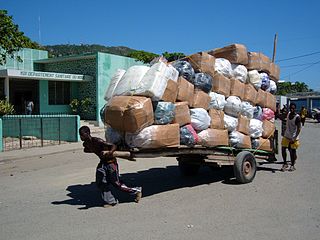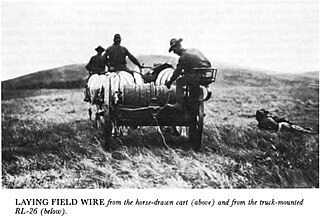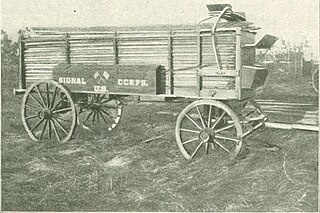
A telephone is a telecommunications device that permits two or more users to conduct a conversation when they are too far apart to be easily heard directly. A telephone converts sound, typically and most efficiently the human voice, into electronic signals that are transmitted via cables and other communication channels to another telephone which reproduces the sound to the receiving user. The term is derived from Greek: τῆλε and φωνή, together meaning distant voice. A common short form of the term is phone, which came into use early in the telephone's history.
Digital subscriber line is a family of technologies that are used to transmit digital data over telephone lines. In telecommunications marketing, the term DSL is widely understood to mean asymmetric digital subscriber line (ADSL), the most commonly installed DSL technology, for Internet access.

In telecommunications and computer networking, multiplexing is a method by which multiple analog or digital signals are combined into one signal over a shared medium. The aim is to share a scarce resource - a physical transmission medium. For example, in telecommunications, several telephone calls may be carried using one wire. Multiplexing originated in telegraphy in the 1870s, and is now widely applied in communications. In telephony, George Owen Squier is credited with the development of telephone carrier multiplexing in 1910.

Digital audio is a representation of sound recorded in, or converted into, digital form. In digital audio, the sound wave of the audio signal is typically encoded as numerical samples in a continuous sequence. For example, in CD audio, samples are taken 44,100 times per second, each with 16-bit sample depth. Digital audio is also the name for the entire technology of sound recording and reproduction using audio signals that have been encoded in digital form. Following significant advances in digital audio technology during the 1970s and 1980s, it gradually replaced analog audio technology in many areas of audio engineering, record production and telecommunications in the 1990s and 2000s.

A cart or dray is a vehicle designed for transport, using two wheels and normally pulled by one or a pair of draught animals. A handcart is pulled or pushed by one or more people.

A digital subscriber line access multiplexer is a network device, often located in telephone exchanges, that connects multiple customer digital subscriber line (DSL) interfaces to a high-speed digital communications channel using multiplexing techniques. Its cable internet (DOCSIS) counterpart is the Cable modem termination system.

A wagon or waggon is a heavy four-wheeled vehicle pulled by draught animals or on occasion by humans, used for transporting goods, commodities, agricultural materials, supplies and sometimes people.

An intercom, also called an intercommunication device, intercommunicator, or interphone, is a stand-alone voice communications system for use within a building or small collection of buildings which functions independently of the public telephone network. Intercoms are generally mounted permanently in buildings and vehicles. Intercoms can incorporate connections to public address loudspeaker systems, walkie talkies, telephones, and other intercom systems. Some intercom systems incorporate control of devices such as signal lights and door latches.
A limber is a two-wheeled cart designed to support the trail of an artillery piece, or the stock of a field carriage such as a caisson or traveling forge, allowing it to be towed. The trail is the hinder end of the stock of a gun-carriage, which rests or slides on the ground when the carriage is unlimbered.

The Australian Light Armoured Vehicle (ASLAV) is an eight-wheeled amphibious armoured reconnaissance vehicle of the LAV II family used by the Australian Army. It was built by General Dynamics Land Systems Canada, and developed from the U.S. Marine Corps' LAV-25 and Canadian Army's Bison armoured fighting vehicles.

Thornycroft was an English vehicle manufacturer which built coaches, buses, and trucks from 1896 until 1977.

A digital subscriber line (DSL) modem is a device used to connect a computer or router to a telephone line which provides the digital subscriber line (DSL) service for connection to the Internet, which is often called DSL broadband. The modem connects to a single computer or router, through an Ethernet port, USB port, or is installed in a computer PCI slot.

Asymmetric digital subscriber line (ADSL) is a type of digital subscriber line (DSL) technology, a data communications technology that enables faster data transmission over copper telephone lines than a conventional voiceband modem can provide. ADSL differs from the less common symmetric digital subscriber line (SDSL). In ADSL, bandwidth and bit rate are said to be asymmetric, meaning greater toward the customer premises (downstream) than the reverse (upstream). Providers usually market ADSL as an Internet access service primarily for downloading content from the Internet, but not for serving content accessed by others.

A modulator-demodulator or modem is a computer hardware device that converts data from a digital format into a format suitable for an analog transmission medium such as telephone or radio. A modem transmits data by modulating one or more carrier wave signals to encode digital information, while the receiver demodulates the signal to recreate the original digital information. The goal is to produce a signal that can be transmitted easily and decoded reliably. Modems can be used with almost any means of transmitting analog signals, from light-emitting diodes to radio.

The K-1 cart is a wire cart type K-1. It comprises a 2-wheel reel cart used for the rapid laying and recovering of telephone and telegraph lines in the field. It is completely equipped with a reel, mechanically rotated and controlled, 1 chest with wire-laying equipment, a driver's seat, and appropriate parts and fittings specially designed and used for only on this cart; designed to carry 5 miles of wire, type W-39. It was formerly known as "Wire reel cart, type N".

The K-2 Lance wagon is a light wagon approximately 14 ft long, equipped with a high box body running its entire length, the body surmounted in front by a driver's seat; tool and supply containers are attached to either side of the box; proper re-enforcements are provided and suitable brakes are attached; rear wheel diameter 4 ft 8 in; gauge 4 ft 10 in; height of box body 3 ft 9 in; width of box body 3 ft 4 in.

The K-4 cart is a 2-wheel strongly constructed signal cart similar to artillery caissons, but equipped for carrying signal equipment; used with the Wire cart, type K-3, to form the wagon formerly called "Pintle wire wagon, M1910".
The K-8 cart was a two-wheel horse-drawn cart used by the U.S. Signal Corps, designed for transporting in the field a large assortment of signalling equipment in the field. The cart's gauge is 5 ft 2 in, the wheel rims 2+1⁄2 inches wide, and the wheel diameters are 5 ft. The body of the cart consists of a large chest surmounted by a driver's seat which is 44 inches wide, 27 inches high, and 5 ft 4 in long. It is mounted upon commercial wagon springs, and the interior is equipped with partitions suitably arranged for separating and holding rigidly in place the parts of equipment, type SE-6.

The K-5 truck is a light automobile truck with a 10 feet 4 inches (3.15 m) wheelbase, standard automobile gauge, and 35 in (89 cm) wheels; length from front of radiator to rear of body 15 feet (4.57 m); equipped with single top; formerly marked with the Signal Corps emblem and the words "Signal Corps, U.S. Army" and also with the name "Maintenance truck No.5" or "Tender for radio tractor No.3".
This glossary of electrical and electronics engineering is a list of definitions of terms and concepts related specifically to electrical engineering and electronics engineering. For terms related to engineering in general, see Glossary of engineering.
















